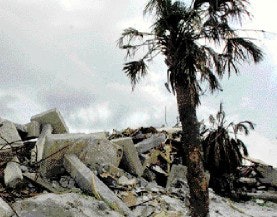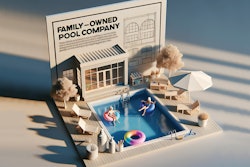
Most disasters — even the worst ones — drop out of the news cycle long before the disaster has cycled out of the lives of its victims. When the 2004 hurricane season pummeled Florida with an astonishing four major hurricanes, it dominated the print and broadcast news and the rest of the country paused to gasp at the images of destruction. But the news cycle ran its course, and soon the national media were frothing over the next headline-maker.
As the 2005 hurricane season looms, parts of Florida are still being punished by the '04 hurricanes. Many people are still living in Federal Emergency Management Administration trailers. And even the lucky ones — the ones who are living in their own homes — are still coping with long waiting lists to have repairs made.
While the pool industry has righted itself for the most part, the pool-enclosures segment of the business is having the hardest time recovering. The sheer volume of the destruction, the labor and materials shortages and the lack of a replacement-market infrastructure combine for a seemingly intractable problem. But out of the ashes may well rise a better product.
Situation Report
"It's hard to imagine if you're not in Florida and you haven't driven through to experience it," says Wendy Parker, director of marketing for the Florida Swimming Pool Association. "It was surreal, the kind of damage that happened. Ten-foot-high piles of tree limbs and garbage; then think about it happening three times, like it did in Orlando. There are people in all parts of Florida that were affected by the hurricanes eight months ago who still do not have houses."
Those fortunate enough to come through the storms with their houses and pools intact likely didn't have the same luck with the ubiquitous screen enclosures that are practically a Florida trademark. According to a F t. Lauderdale Sun-Sentinel report, 15 to 40 percent (depending on the location) of Florida's screen enclosures were flattened by the hurricanes. "Driving around you see them all over town that are still damaged or you see the screens hanging," says Steve Bludsworth. "It's been a big problem. We've got customers that, almost a year later, don't have a screen and they can't get any firm date of when they're going to get one." Bludsworth owns All-Pool Service and Supply in Orlando, serves on the board of the FSPA and is a national vice president to APSP. He explains that a perfect storm of conditions made the four hurricanes of '04 particularly destructive to the pool-enclosures segment of the industry.
Unlike the roofing or siding industies, he says, there isn't a market for repairing existing screen enclosures. "About the only time anyone replaces one is if a freak tree limb falls on it," says Bludsworth. "Ninety-eight-point-something percent of the new screen enclosures go up on new pools. So when the smoke cleared, you had the same demand for new pools needing screen enclosures plus the demand for tens of thousands of replacement screens."
Compounding the problem of a nonexistent repair and replacement industry is the lack of a comparable screen enclosure market outside the state. "What made it worse is that screen enclosures are like a Florida phenomenon," says Bludsworth. "Here in Orlando after the hurricanes blew through there were roofers and tree guys and you saw license tags from all over the country here. But there were no other pool-screen guys to bring in."
As one would expect, shortages of labor and materials contributed — and in some areas continue to contribute — to the mess. The sheer volume of the destruction alone put stress on the supply of labor. And new construction seems only to have paused before continuing at its pre-disaster rate.
"I think we're in a boom," says Alan Cooper of Artesian Pools in Orlando. "Everyone I talk to, for the most part, they wish they had more people to build the pools they've sold."
Cooper, who is treasurer of the FSPA, figures he lost two to three weeks of production during the storms, but hasn't seen his business slow down. "Basically for about a whole month during the storms we didn't dig a pool because we knew every time we'd turn around there was another storm."
The service sector also scrambled for awhile. "We were insane-busy after the hurricanes," says Bludsworth. "But then we caught up with all the burned-out motors and all that stuff, it actually kind of came to an end. Even most of the roofers I think are caught up, at least in Orlando. But the screen enclosures are the one thing that haven't come to an end."
"Prior to the hurricanes, most people were extremely busy anyway," says Michael Sonsini, partner in Screen Builders in West Palm Beach and president of the Palm Beach chapter of the Aluminum Association of Florida. "My backlog was $4 million, and my backlog right now is $12 million. I'm probably one year behind."
The labor shortage has spawned some bad situations for both consumers and would-be entrepreneurs. "When you have these storms, it's very easy to get into the rescreening and replacement business. So crews that are borderline all of a sudden think they're experts and start their own business." Many of them, Sonsini says, operate without the proper insurance or licensing. "The most dangerous task in the industry is balancing yourself on a 2-inch beam 12 to 20 feet in the air, trying to replace the screen in a roof. If they don't have proper insurance, the homeowner that's trying to save money and time has to pay for that person's injury, or worse." All of that leaves established companies short on labor and competing with fledgling operations, many of which have cut corners.
Another problem is simply getting the material. According to a story in the May 16 Sarasota Herald-Tribune , screen shortages and then aluminum shortages ratcheted up the frustration for consumers waiting to have their enclosures replaced. It's enough of an issue that the Herald Tribune and the Sun-Sentinel both ran substantial stories on the problem in May and April, respectively.
Sonsini says the aluminum shortage has stabilized but the screen cloth is still in short supply. "There are only two companies that we know of, and they can't keep up." He says. "There's a lot more screen cloth needed than aluminum framing, statewide."
Layers Of Problems
Destroyed pool enclosures are more than an inconvenience; compromised safety is an even more important concern. In many cases, the pool enclosure served as a layer of protection. "The issue that the industry is very aware of is that now these people have open backyards with pools that don't have any protection. That's probably as much of an issue as anything else," says Parker. Bludsworth says he has seen baby fences or construction fences erected to provide a safety layer while the homeowner awaits repairs or replacement.
For service companies, the missing enclosures mean more work, but not necessarily more profit. "It makes our job a lot harder," says Bludsworth. "The screened-in pool obviously keeps all the leaves and stuff out of the pool. Our techs have a messier, dirtier pool to deal with." Bludsworth's company is absorbing the loss for now. "If somebody new calls and they don't have a screen, then we're going to price the job accordingly, but we didn't feel it was right to say to somebody who's been a customer for years and years, 'We're going to charge you more money because you lost your screen in the hurricane.' We just figure some time in the near future surely they'll have a screen again."
Builders have perhaps had the largest assortment of problems. "We have renovations that are done and the pool's full of water and the people are probably going to be waiting another year for a screen enclosure," says Bludsworth. "New-pool builders — especially the smaller guys that don't have a lot of clout — simply can't get screens. Jobs that were sold, where the pool builder had the name on the dotted line, and is obligated to build the pool — are on hold because he can't get the screen or it's gone way up in price. It's not a pretty thing."
Cooper says some builders have changed their sales pitch. "I don't think the public has had any less demand, but I think that builders are trying to show there are alternatives that you could use to stay away from the screen enclosures," he says. "Of course there's fencing, and a lot of concerns are with mosquitoes and there are some new products out there — high-tech bug zappers — so there are people that are opting for that approach. But there's not a whole lot of alternative to what a screen enclosure does."
Not surprisingly, the builders who forged solid business histories prior to the storms are having the least amount of trouble post-storm. "A lot depends on what you've done and what relationships you have," says Cooper. "If you have been consistent with your screen company, then you're going to get preferential treatment as opposed to someone who has bounced around wherever they can get better pricing. Companies say, 'We're going to take care of our customers who have been loyal to us,' like in any industry."
Better, Stronger
As with any disaster, there's been a lot of analysis of how the damage could have been prevented or at least minimized. It seems clear that changes are ahead for new enclosures.
"The engineers have revisited their math formula methodology in calculating the roof-beam and wall-upright sizes," says Sonsini. "The beams are going to be a lot stronger." Structures built to code after 2000 were supposed to be able to withstand 140mph winds. "Those standards are set by the state of Florida building code, but it was interpreted by some engineers incorrectly," says Sonsini.
Revised calculations will mean stronger enclosures, but at a cost. "They will be built heavier. A typical crew now is two skilled installers," says Sonsini. "The heavier method might require three to four guys. That means more money for more labor. There are times you will need a hydraulic lift, too, because of the weight of the roof. There's less risk of worker's comp claims if you use the machinery wisely." Sonsini says it will at least double the price of most installations. He isn't worried about customers' reactions to the higher prices. He compares it to an automobile purchase; there are still enough people who are willing to pay for safety to keep the Volvos rolling off the production lines.







































